Panama - the Canal

Lovesail
Sun 15 Feb 2015 03:02
|
08:54.56N 079:31.43W
15 Feb 2015
Whoo Hooo! Yes, we’ve done it. We are through the Canal and in
the Pacific. Now comfortably anchored outside a little marina called La Playita
just a couple of miles from the sea lock of the canal.
Of course I want to tell you about the transit, but a couple of other
things first.
History: I read a fantastic book called The Path between the Seas by David
McCollough which gives a comprehensive history of the building of the
canal. It reads like a thriller since there were so many high and low
points, obstacles, disasters, tragedies and finally success. It’s a
miracle that it ever got built. The French started off, under the
leadership of de Lessops, fresh from his triumph of constructing the Suez
canal. It was a disaster from the start: no overall plan, tragically
underestimating the force of the river Chagres which adjoins the path of the
canal, inadequate survey of the topography and, most importantly, geology of the
land, ghastly conditions in the wet season, and tragic casualties due to disease
(mostly malaria and yellow fever). Eventually they went bankrupt but they
still held the concession from the Colombian government, Panama being a province
of Colombia at that time.
It took the untimely death of President McKinley of the USA to revive the
story. Theodore Roosevelt was then thrust into the presidency and he was
keen to have a canal built, for strategic reasons, to link the East and West
coasts of the USA by sea without the need to go around Cape Horn. But
which canal? The Americans had already developed plans for a canal through
Nicaragua and it was only after much hectic lobbying that the Senate eventually
agreed to take over from the French in Panama. But this was subject to the
agreement of the Colombians who were very demanding, much to the annoyance of
Roosevelt. It took a revolution in Panama that gave them their
independence for the situation to be resolved, and it remains questionable just
how much of a hand the Americans had in orchestrating the revolution. The
new government of Panama then granted a new concession to the Americans on very
favourable terms. So now the engineers could get to work. But it
took massive advance in medical science to overcome the threat of disease in the
region. The American medics set about eliminating mosquitos from Panama
and were largely successful in turning a disease ridden hell into a pleasant
tropical land in which northerners could live and work without fear of
disease. Of course the engineering challenges remained enormous, but the
decision was made to dam the river Chagres, thus taming its fury in the wet
season and creating an artificial lake – today’s Lake Gatun – at 85 metres above
sea level through which the ships would pass. This vastly reduced the
quantity of excavation required to build the canal but instead presented the
challenge of constructing huge locks at each end of the canal. In its day,
this project was the largest construction site in the World, employing over
40,000 people. It took over 10 years and huge determination by the
Americans to finish the canal, which opened in 1914. It’s a testimony to
their skill and vision that it remains today in perfect working order with
little changes to the locks although the channel through the lake and the cuts
have been deepened and widened considerably since that date.
Which now brings us to the new locks. With much foresight, the
Panamanians recognised that the Canal needed to expand its capacity into order
to cope with increased shipping, both is quantity and size. The existing
locks impose a restriction on size to the so-called Panamax container
vessels. But shipping companies have been building much larger ships that
are unable to passage the canal, so the decision was made, some years ago to
construct new, bigger, deeper, longer locks at each end of the canal, and to
expand the channels in the lake. Construction started some 10 years ago
and once again a miracle of engineering is taking place and it is hoped to open
the new locks in late 2016. Thanks to Jimmy Cornell, our group was granted
a tour of the construction site on the Atlantic (Caribbean) side of the
canal. We set off in a bus with a senior official of the canal authority
as our guide. It’s another set of superlatives! Hundreds (or thousands) of
workers, trucks, cranes, all beavering away, guided by some unseen hand.
As for the locks, there are a number of interesting eco facts. Although
much larger that the existing ones, they will use less fresh water due to a
system of water recovery basins: as one lock is drained, the water is passed to
a basin that can then be used to fill a lower lock, etc. Apparently not a
new technology, but it’s never been applied on this scale before. In
digging the locks, great care has been taken to preserve the wildlife with
animals, plants, etc. all removed carefully to new locations. Hundreds of
crocodiles have had to be caught, tied and then moved. The new locks, by
permitting larger vessels to pass, rather than take the long route, will result
in much fuel saving (and carbon saving). To give you an idea of the scale
of things, each of the new lock gates weighs 4,000 tons. They were made in
Italy, brought by ship, unloaded to transporters that carried them, on specially
constructed roadway, to the locks and then moved into position with barely
inches to spare. We’ve seen them, and they are big!
And then came the surprise. Our guide, an American gentleman, friend
of Jimmy and project manager of the project, announced that we were to drive
through the locks! See for yourself.
  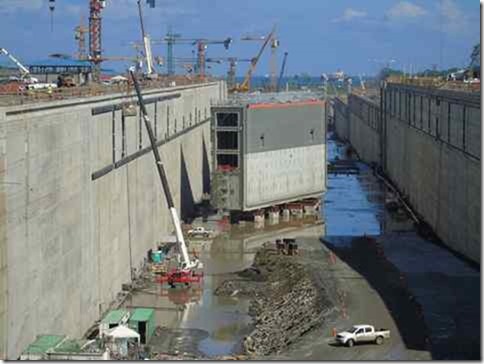 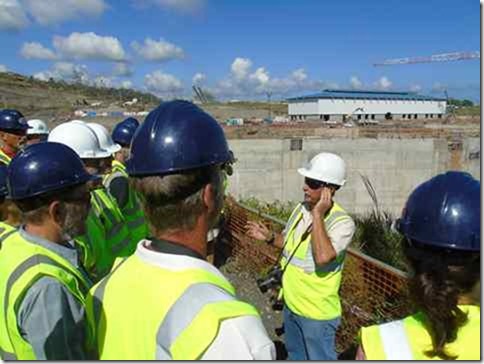  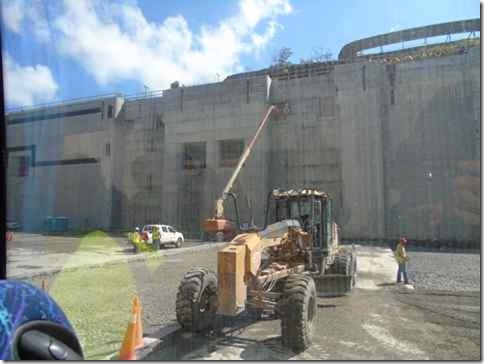  Two gates in place, close up
 Later in the day, we were also privileged to be received by the chief
executive of the canal authority, Sr. Jorge Quijano, in the magnificent
headquarters building on the Pacific side. Sr. Quijano signed our log
books and offered us kind hospitality.
 The HQ has some beautiful murals by the American artist William van Ingen
showing the heroic construction of the canal. Here are a couple.
  There are also evocative paintings by other artists such as these
    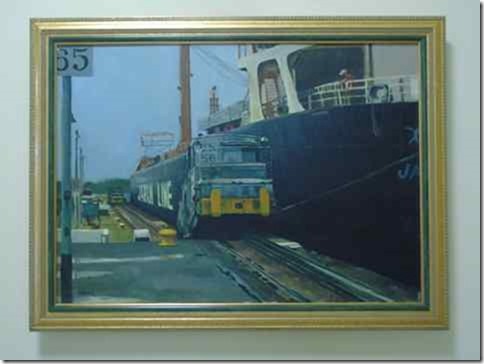   Thank you Jimmy.
 Okay, so now our transit. It was announced that Lovesail would transit on
14/15 Feb together with 5 other yachts from our group. The other 6 yacht
in our rally would transit 2 days later. So we picked up our line handler,
Eric, (it being a requirement to have four line handlers and one helmsman on
board) and off we went on Saturday afternoon to the rendez-vous point near the
canal entrance, caller the Flats. There we were joined by our “course
advisor” or pilot, Hector, and at about 6:30 pm we entered the first lock,
rafted up to two other yachts and following on behind a cargo vessel.
Being a catamaran, we were in the centre of the raft, meaning that we didn’t
have to have lines ashore but instead we were responsible for driving the raft
in and out of the locks. All goes well, the gates shut and the water
begins to boil.
      The Atlantic locks are a staircase of three locks rising 85 metres in
total, roughly 30 metres each. Each locking takes about 20 minutes so it
took about an hour for us to reach the lake, by which time it was dark. We
then turned left and proceeded to raft up to a buoy – all six yachts – for the
night. Meanwhile Hector was picked up by a pilot boat, but Eric stayed on
board for the night.
  At 6am, our new pilot, Oscar, joined us and we set off across the lake to
the Pacific locks, arriving at the Pedro Miguel lock at about 12:30. On the way
we passed through the Gaillard cut and the famous Culebra cut that had caused
the original builders so much difficulty.
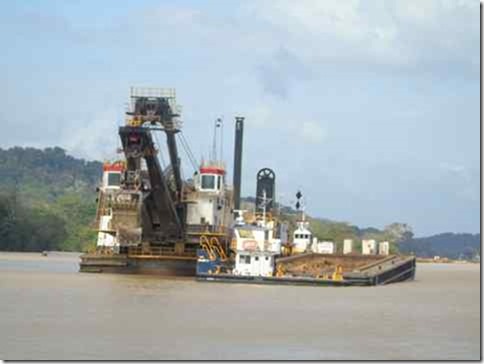    And then it was time to descend and emerge into the Pacific and say goodbye
to our helpers.
   |